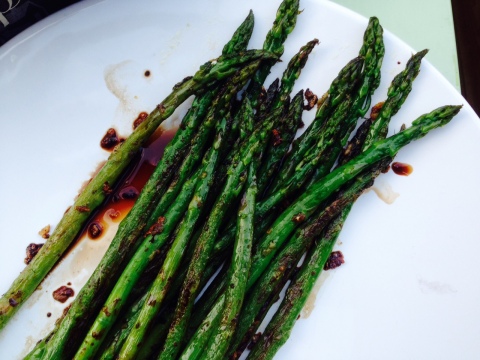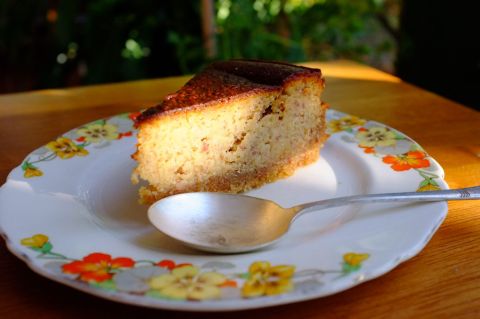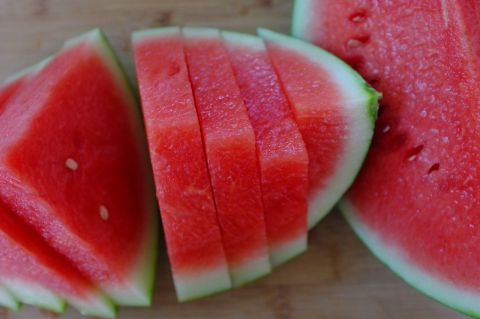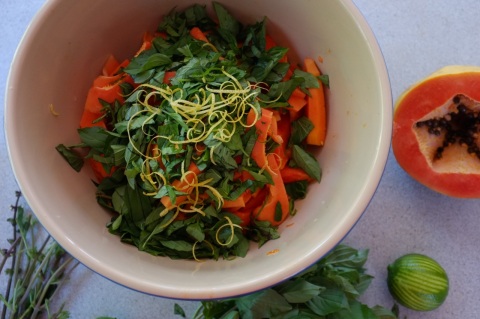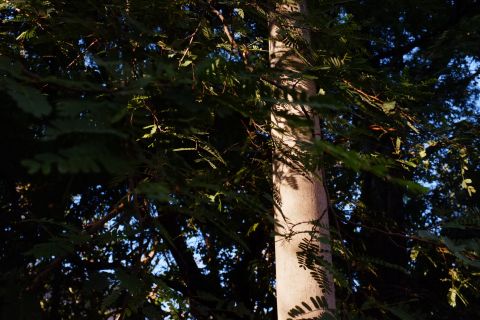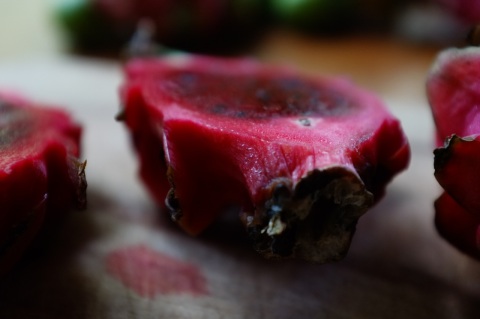spring, partings and asparagus
June 1, 2015 § 2 Comments
The sun was shining with so much intensity when I left Toulouse. I am not sure if I was imaging it or not, but the tomatoes growing on our balcony seemed to be gaining an inch a day. Everything, including me was pushing up and reaching for the summer. On my last night, we sat there together, my feet in his lap, eating asparagus with French cheese and wine, looked out over the balcony to the canal. Nostalgia deep in my heart. I missed him before I even left.
Fried asparagus
Take a bunch of fresh asparagus and cut off the woody ends. Place 1 teaspoon of butter and 1 1/2 teaspoons oil in a large saucepan set on medium high heat. Once the oil is hot, add just enough asparagus to comfortably cover the bottom of the pan and gently sauté tossing every now and again so that all the sides become lightly browned. If you want you can place a lid on top of the pan to steam them a little as well. After 2 – 3 minutes add 2 cloves freshly crushed garlic and salt and pepper to taste. Continue cooking until the asparagus are just beginning to soften but still are bright green with a light crunch. Transfer to a plate and drizzle with a touch of balsamic vinegar. Repeat the process until all your asparagus are gone. Serve with some crusty bread and enjoy.
Maple syrup and butter baked pumpkins/delicatas with walnuts and crystallised ginger
December 2, 2014 § 2 Comments
I spent the most part of September off the east coast of Maine on a small Island called Deer. The home of two very very dear friends who I had come to visit and celebrate with in their wedding. I slept in an old combi van parked in the little clearing made in the birch and cedar forest where the newly weds were building their house. I woke each morning to smoking white breath, a body just warm enough under a pile of thick blankets and my ears slowly attuning to the sounds of the morning; – the distant fog horn; the creep of the mist through the bays and forested islands; the sun unfurling the slender fern fronds. There my heart grew a certain happy glow from sipping on 44 north coffee, swimming in icy waters, eating my fair share of apricot pie, AND freshly picked homegrown delicatas baked with butter, maple syrup and crystallised ginger (thanks to new friends for teaching me just how good this could be!). This is the recipe I am sharing with you today, straight from the oven it shines gold like a piece of heaven itself – and it is all of that and more in your mouth.
Because I had never heard of delicatas before going to America and I am guessing you might not have either, I have substituted delicata for pumpkin which, without sounding as exotic, tastes almost as good. But if you can get your hands on some I suggest giving them a go. A note to those in the Norhtern Hemisphere – this is the time to look – that is – autumn to early winter.
Maple syrup and butter baked pumpkins with walnuts and crystallised ginger
Enough organic grown pumpkin (or delicatas) to cover a large backing tray (about ½ – 3/4 of a medium sized pumpkin)
2 – 3 tablespoons pure maple syrup
1 tablespoons butter
1 tablespoons olive oil
2 tablespoons roughly chopped walnuts
1/3 cup crystallised ginger pieces chopped to the size of your liking
Salt and Pepper to taste
Pre heat your oven to 200 degrees C/400 degrees F.
Chop your pumpkin/delicatas, skin and all, into big bite sized chunks (I always leave the skin on as it helps hold the flavour and the juices).
Spread on a lightly greased backing tray.
Gently heat the oil, butter and maple syrup in a saucepan until the butter is just melted. Drizzle over the pumpkin.
Sprinkle with the walnuts and ginger, season with salt and pepper and give a light toss.
Pop in the oven and roast, stirring once or twice, until tender and beginning to brown. About 30 minutes.

late september
September 28, 2013 § 3 Comments
I had a dismal attempt at trying to grow watermelons this year. The process started with me very excited. I made a little round bed full of compost and manure and planted two little seeds inside. They sprouted and grew… A little… I watered them and they grew some more. They bloomed tiny little flowers and even grew one tiny little watermelon. Then I went away and the little watermelon shrivelled up. Then the rest of the vine shrivelled. And one day they were dead. And that was that.
The sun is relentless here. Unforgiving. I realise my mistake, I shouldn’t have put them in a place that gets all day sun, and I should definitely have mulched them more.
But still, I have been managing to eat some of the very best watermellons I ever had. The local ones are cheep and abundant at this time of year. They are a deep bright pink and so so sweet.
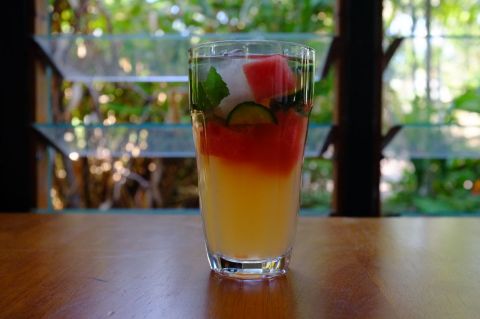
So I have a recipe for you today, a drink, and a very refreshing one at that. It comes out of the beautiful cookbook The New Persian Kitchen. Its a watermelon, mint, and cider vinegar tonic!
Author Notes: “Even if drinking vinegar sounds like a dare — and maybe that’s why you ordered it — it’s anything but. It’s sweet and sour and icy-cold. It vibrates and clangs with fruit and vinegar, and soothes with sweetness and mint. It is the most refreshing drink you will have this summer”. From The New Persian Kitchen
Recipe for Watermelon Mint and Cider Vinegar Tonic
Makes about 5 cups concentrate
3 cups water, plus more to serve
1/4 teaspoon sea salt
1 cup honey
6 cups coarsely chopped watermelon
1 cup tightly packed fresh mint, plus more to serve
1 cup apple cider vinegar (preferably with the mother because that is the best kind for you)
Ice cubes, cucumber, and lime to serve.

- Boil the water and salt in a medium saucepan. Add the honey and allow to dissolve before removing from the heat.
- Combine the watermelon and mint in a large bowl and stir in the hot honey water. Leave to cool to room temperature.
- Once cool, add the vinegar and allow the mixture to steep in the refrigerator for several hours or up to overnight.
- Strain the mixture and eat the watermelon chunks, if desired.
- Store the concentrate in a clean glass jar in the refrigerator for up to 1 week.
- To serve, pour 1/4 cup of the concentrate into a glass over ice and dilute with 3/4 cup water. Garnish with the watermelon, cucumber, and mint.

snake beans
July 15, 2013 § 2 Comments
The Tropical Garden Spectacular was on a few weeks ago. At the botanical gardens under trees with impossibly huge canopies I watched some local food cooking demonstrations. Lined up on straw bales with the green grass at our feet, some glimpse of paradise on the warm breeze, the chef Selvam Kandasamy from Saffrron, taught a small group of us how to make snake beans, sautéed in spices with coconut and curry leaves. And this my dear friends is a dish to be celebrated.
Snake beans are the lanky tropical equivalent of the green bean and you would be forgiven for thinking them somewhat tough and woody with little flavour. This recipe however does them justice. It is full of flavour, crunchy, slightly sweet, bright green and turmeric yellow. The coconut and chili melts on your tongue. The intermittent curry leaves are bright in your mouth. The beans are cooked hot in a wok for just the very right amount of time making them softly crunchy and fluorescent.
I have made this recipe many times since then and each time I have continued to love it. It is similar to the original made by Selvam Kandsamy except I have used coconut oil instead of peanut oil.
Spicy Snake Beans with Coconut and Curry Leaves
Serves: 4 – 5 as a main or 6 – 8 as a side dish.
Note: If you are in distant and cooler parts wanting to use something more locally appropriate I am sure green beans would also make a good substitute.
3 Tbsp pure coconut oil
2 flat tsp brown mustard seeds
2 flat tsp turmeric
1/2 tsp salt
1 red onion finely diced
1 whole fresh red chillis (you can also use 1 tsp dried chilli flakes instead)
1 Tbsp Split yellow lentils (optional)
4 cups chopped snake beans
1/2 cup shredded coconut
A good handful fresh curry leaves
Extra salt to taste

Prepare all your ingredients before hand. Once you start cooking it all happens fast.
In a wok heat the oil on a medium to high flame until hot. Add the mustard seeds, turmeric, onion, and salt. Stir until the onions turn just translucent, then add the chilli and lentils. Continue stirring and add the beans and coconut stirring until the beans are just cooked through but still have a crunch and are bright green. Add the curry leaves and remove from heat.
It is lovely served as a side to fish or on its own with brown rice.
I hope you like it as much as I do.
basil and papaya
June 6, 2013 § 2 Comments
If you are one of those people who like papaya, this one is for you. I know, I have done it before with strawberries and basil, a recipe good enough to serve to the prime minister of Australia, and perhaps I should have just left it at that. But with fresh papayas straight from the tree in our back yard and thai basil and limes also in the garden I couldn’t help myself.
I can’t promise it will blow your socks off but papaya, lime and thai basil salad is in every way good. The pictures say it all.
the story of how I learnt to make yoghurt
May 18, 2013 § 3 Comments
The story of how I learnt to make yoghurt is not a simple one. It spans some 5 years and two continents. It begins just after I finished my undergraduate degree, when I spent a year in India, getting lost and trying to find myself again. As you do when you are 24. During that time, I spent a couple of months volunteering in a Buddhist nunnery teaching English in the Gompa. The nunnery was in the far north of India, in a place called Zanskar, a mountain range that runs on the Tibetan side of the Himalayas. Being in the rain-shadow of the tallest mountain range in the world, Zanskar is something like a desert, it never rains and vegetation on the surrounding slopes is scarce. But in the valleys where there are glacial streams, fluorescent green fields make a stark contrast to the moonscape hills. Here the grass grows with a certain urgency learnt through evolution in a land where warmth and water are ungenerous.
But signs of life are not restricted to the stream soaked valleys. On the hill tops prayer flags beat in the winds, some are very old, worn and tattered with almost all their prayers lifted to the breeze. Fossils scatter the myriad of paths that weave their way out of town along scree slopes and over mountain ridges. These benthic remnants a reminder that this very landscape was once hundreds of meters below the ocean.
My journey to Zanskar begins in Leh, with a 26 hour bus ride covering some 400km to take me to the remote valley. As you can imagine, the road is very rough. Because I booked late, I don’t have a seat and so have to make do with the floor where I wedge my way into a somewhat comfortable space between the luggage that fills the aisle. I am not the only one and soon a man falls asleep on my back and another on my knees. After 10 hours of this and with the knowledge of 16 more to go, I begin to feel agitated, my legs and back cramped. From my place on the floor I glance up at a boy standing at the front of the bus without even room to sit. He is smiling and in his smile my anger subsides. The easy nature of the locals and their open acceptance of each situation is contagious. Like other times when I have traveled to developing countries, I am struck by what lessons we have forgotten in a privileged and wealthy world. Not long after, a girl sitting on the seat next to me offers me her lap to rest my head. Gratefully I fall asleep there for an hour or two. Later I find out she is from Zangla, the small village where I will be teaching.
When we finally arrive, tired and dirty from the dusty road, it is late, so I spend the night with the girl from the bus in her family home. Their house is like all the rest in the village, made from mud and cow dung, two stories high, with a flat roof loaded with fodder, wood and dried cow dung to burn in the coming winter.

The next morning I walk through a flowered field woven with a myriad of creeks and streams running to the river. There I wash in water clear as glass before walking the short distance to the Gompa that sits on a small hill on the far side of the village. I am nervous to meet the nuns as they have no way of knowing I am coming, but I am greeted with warm smiles and open laughter.
During my time at the monastery, my relationship with the nuns becomes more like a friend than a teacher and maybe this is why at times it is difficult to get them to come to class. Many of the nuns don’t have much of an interest in learning English, except maybe male and female body parts for which they have abundant enthusiasm. But it makes me question what I am doing. What is the purpose of teaching English? Is it not just another form of cultural imperialism? I still don’t really know the answer to this, but I do know that I am there with others who came before and after me. With a growing number of tourists visiting the region each year and with increasing access to the outside world, western influences are unavoidable. And in general, such change is welcomed by the locals, because with it comes a higher standard of living, the ability to join the rest of the world, to “develop”, to “progress”. I realise I am more sentimental than many of the locals in regard to the loss of traditions and the damage to land and culture that comes with such pursuits. But as I learn from the Buddhists that live there, nothing is permanent, change for good or for bad is inevitable. So perhaps as westerners we should focus on learning from our own mistakes and try to assist those who are following in our footsteps to take on a more sustainable path. Because of this I allow myself some small reassurance that in some tiny way, I am giving the nuns some of the skills they need to communicate with the outside world, so they can speak up and voice their needs and concerns in a shifting landscape. But it is small comfort in light of the stories of rapidly retreating glaciers, water sources drying up, the brain drain as educated children chose to live in far off cities, the introduction of white flour, sugar, packaged food and the plastic litter building up in a place with no formal rubbish disposal system.
So I spend my time practicing the art of just being and trying to help where I can, teaching in the school with the younger nuns, offering small informal English lessons here and there and lending a hand with the cooking.
The kitchen is a good place to be because it is where the nuns meet. Warm and cheeky they laugh and hoot slapping one another on the legs as they sit cross-legged at the low tables lining one wall of the large room. This is where I watch them making yoghurt. Taken fresh, straight from Pashi the Gompa’s resident cow, they heat the milk over a large pot-bellied stove in the middle of the room. Just as the milk starts to simmer but before it boils they pull it off the heat allowing it to cool to the temperature of a hot bath before stirring in a tablespoon or so of yoghurt left over from the last batch. The whole pot is then wrapped in a thick woollen blanket and placed in a corner of the kitchen until the next day when it is eaten with ladakhi bread and butter tea for breakfast.
I become very fond of Pashi and her calf Patel. They are a handsome pair, golden blond with strongly defined features. Their stable is next to my room and at night I can hear them moving around. They give me great comfort. In the evenings I bring Pashi back from the fields where she is tethered on a grassy knoll. The pleasure in the simplicity of it all, walking the cow home with the summer breeze on my face and playing in my skirt.
My room is also made of mud and cow dung, a little square that I can just lie down in. It has a small window and a small door I have to double over in to enter. When it is windy the roof sprinkles dirt to the floor. The scene from my window is vivid. At dusk small birds with round bellies and orange tails sit outside and I try to be very quiet then, any movement and they will fly away. As night draws, the moon illuminates the land with a pale yellow grey light and the shadows of the clouds play on the mountain tops.
Some days I walk to the river, its fast current tempting me, full of the energy of the mountains and sky from which it came. To get there I walk past Mane walls, ancient inscriptions on flat stones piled together. Who placed those first rocks there sending Om Mane Padme Hum to all ends of the earth? The valley big and broad with barely any landmarks, I lose perspective of distance, everything seems closer than it really is. Zhos (a cross between a yak and a cow) graze on the fertile strips where a creek meets the river’s edge. I watch the herders bring them together and drive them home. At the river the current is hypnotising, eddies run in all directions and waves appear to move upstream.
Other days I follow the small stream up behind the Gompa into a canyon that becomes narrower and narrower drawing nearer to its source. There in the rock pools I swim comfortably naked and alone among the pastel green, maroon, and orange of the boulders. The water as glass, streams crystal clear over the rocks, like cloth falling over the landscape, cool enough to make me gasp but warm enough to linger a while.
One night stands out to me in particular. It is nearing the end of my time in Zanskar when we can’t find Pashi. She is not in the field where we left her and must have broken her tether. One of the nuns and I go looking for her down by the river. The moon is half full in the sky and bright enough to lead the way, the stars half obscured by clouds. The green field in the flat of the river runs with small streams and shines moist. The beauty catches my breath. We spend two hours wandering along the water’s edge, through fields and along stone-walled pastures. Finally, defeated, we walk back to the village through the sweet smell of mustard in flower. Back at the Gompa we find Pashi tethered to her stable. One of the other nuns found her and brought her back whilst we were gone. By now it is late and I climb back into my mouse-hole room only to find I cannot sleep. The freshness of the night still on my skin and in my mind, the stars shining on me.
My last day in Zangla, I wake up from my small window to see the sun’s first rays on the fresh snow-capped mountains turning from grey to orange to yellow and finally to white as the day begins. My sleeping bag is slightly wet from rare rain that fell that night. After breakfast the nuns fill my bag with chapatis’ for my journey to Leh. Way to many for me to eat by myself but they insisted I take them all. We hear the bus coming so running out the door, kataks thick around my neck it finally dawns that I am leaving and tears prick my cheeks. I climb onto the roof of the bus. From there the nuns look so sweet waving in their maroon robes framed by the Gompa and the Himalayas. The fresh morning and the smiling mountains feel good on my damp cheeks. I am full with the privilege to have lived a little in their world.
How to make Yoghurt
Before going to Zanskar, I had always been put off by the idea of making yoghurt as every recipe I had come across called for either a yoghurt-maker or thermometer, making it all seem far to complicated. But after seeing the nuns do it, I realised all you really needed was a large pot, a warm place, a blanket and a bit of careful watching.
But still I kept putting it off and it wasn’t until a year ago when I was asked to give a fermentation workshop at CERES that I decided I better give it a go. I couldn’t even pretend to be an expert if I had never made yoghurt before. So I started researching. It turned out I didn’t need to go far. In my bookshelf was my much-loved copy of Wild Fermentation and in it a recipe for Yoghurt that doesn’t use a yoghurt maker or a thermometer. This was what I’d been waiting for.
The most important thing you need when making yoghurt is a warm and cosy place to rest it in. I usually pre-heat a small Esky by filling it up with hot water from the tap. I then empty it, dry it out and fill it with towels and if it is winter and really cold, a hot water bottle or some jars filled with warm water as well. But really what you need is a place that will cool down very slowly. I have also heard of people making yoghurt in a thermos and I’m sure this could work too.
Yoghurt Recipe makes 1 litre
Equipment
1 litre jar
Insulated cooler/esky
Ingredients
1 litre whole organic milk
1 Tbsp fresh yoghurt (check it has live cultures)
Method
Pre – heat your jar and cooler with hot water, so that they won’t drain heat once you pour in your yoghurt.
Slowly heat your milk, paying close attention, until tiny bubbles start to form but before it starts to boil (if you have a thermometer, this is 80°C/180°F). Stir frequently to avoid burning the milk. The heating is not absolutely necessary, but it helps to get thicker yoghurt.
Allow the milk to cool until it still feels hot but is not so hot that you can’t keep a clean finger in it. You can quicken the cooling process by placing your saucepan in a bowl of cold water. But be careful it doesn’t cool too much. The optimum temperature is as mentioned above – about 40°C/110°F).
Mix the starter yoghurt into the milk. Make sure you don’t get tempted to add more yoghurt thinking it will help to make a thicker end result as it will do the opposite. Poor into your jar, screw on the lid and place in your pre heated “incubator”. If you see fit, add some jars with warm water and/or a hot water bottle (with warm water in it) to help maintain the temperature. Leave in a place where it won’t be disturbed as it doesn’t like being jostled.
After 8 – 12 hours, check on your yoghurt. It should have developed a “tangy flavour and some thickness” .
Store in the fridge and consume within 4 weeks, saving some for your next batch.
Finally, make sure you have a look at how to make Labnah cheese from yoghurt here and some of the things you can do with Labnah here.
pho
May 6, 2013 § Leave a comment
Its been two and a half months since we moved to Darwin. In that time, I have started making a basket out of scrap material collected over my 29 years, made huge amounts of pickled cucumbers, watched far to many murder mysteries, tried to commit myself to balancing on my head at least once a day, finally got a job, and consumed large quantities of pho. AND pho could just so happen to be the very best thing that has happened to me since I arrived. A traditional Vietnamese soup, it’s so easy to make, and so so tasty.
As I have learnt, there are a few things you need to consider when making pho. The first is your stock. I always recommend people make their own stock out of organic meat, rather than buying it from the store. Not just because it tastes so much better but because homemade stock is very very good for you.
For pho, I have made and used stock from chicken, beef and fish. All work well, just adding a slightly different flavour. Just remember that fish stock can be quite strong, so adjust the quantities as needed.
The next thing you need to consider is the herbs you garnish your pho with. My favourite by far is Thai basil, but you can also use coriander, mint and traditional basil or combinations of each.
How to make stock
To make stock, I usually use the leftover bones and carcass from the previous nights roast dinner (about 1 – 2 kg). If I haven’t had a roast in a while, I will sometimes use 4 chicken drumsticks instead. I will place them in a large pot with one or two bay leaves and a good pinch of salt. Some people add vegetable scraps too and you can if you want. This is then covered with water, (about 4 – 6 litres) and brought to the boil before leaving to simmer for 3 – 4 hours, skimming the scum as needed. This can then be frozen into serve size portions (say two cups each) and used when needed. It will keep in the fridge for about 4 days and in the freezer for 3 – 4 months.
Pho (serves 4)
For the broth
4 cups stock
4 cups water
4 star anise
1 – 2 cinnamon quills
1 inch piece of ginger cut in half
1 onion cut into quarters
4 cloves garlic peeled
1/3 cup fish sauce
To serve
375 g flat rice noodles
Roughly 300 g organic beef very thinly sliced
2 limes cut into quarters
A bunch of fresh Thai basil
About 200 g beansprouts
2 fresh chillies cut into strips
Chilli sauce (optional)
Hoisin sauce (optional)
Additional fish sauce
Method
Place, stock, water, star anise, cinnamon, ginger, onion, garlic and fish sauce in a large saucepan and bring to the boil. Cover and allow to simmer for around 30 minutes.
In the meantime, cook rice noodles as per package suggestions, and arrange limes, basil, bean sprouts, chilli and sauces on a serving plate in the middle of your table.
Divide the cooked noodles into 4 bowls. Place the raw beef strips on top and cover with steaming hot broth. The hot broth will cook the meat as it makes its way to the table. Allow people to add the additional ingredients in the centre of your table, as per their liking.
all about dragon fruit, iced green tea and being grateful
March 21, 2013 § 1 Comment
There have been days when I have watched the clouds and the sea, breathed in the hot air, walked through the night when its pouring rain, listened to the jungle foul in our back yard, rode home at dusk in an electric sky, eaten green paw paw salad, bought armfuls of local mandarins, rambutans and dragon fruit at Rapid Creek market and loved this place. And then there have been days when I have questioned every reason I’m here and what it is I am trying to pursue. I have missed my southern friends, a good cup of coffee, cute little cafes with beautifully dressed waitresses, newspaper headlines that resemble some mild form of intelligence and a local radio station that I enjoy listening to. Luckily these moments can usually be fixed with a jar of pickles and an hour or so spent in the hammock watching the evening sky. Or eating oatcakes and admiring the little green tree frog that croaks outside our kitchen window and even sometimes comes in for a visit. And if this doesn’t work, a few stern words to myself about how great it is to be a little lost and not know what lies ahead because that way anything is possible.
But today is not a pickle and hammock day. Today is a green tree frog, cloud watching, rain walking day and I am grateful. I am grateful to my friends and family who have rung me up to ask me how things are going up here and told me not to worry, I’ll get a job soon. I am grateful to that person who is going to employ me sometime soon. And I am grateful to my new friends, one of whom wrote me a welcome card when we arrived, made me iced green tea and taught me the only way to eat dragon fruit – which is with lime. Or I guess lemon would probably work too.
I had only tried dragon fruit once or twice before and never really liked it or given it much thought. Perhaps this was because I lived in the south and it was far away from its tropical context. But more importantly, I think it was because it was lacking in preparation. Lime turns this fruit from somewhat dull and strange in taste to subtle and delicious, just like that. I hate to think of all the people who may have given up on it like I did, simply because they had never tried it this way. So, if you ever come across one of these striking fruits, that grows on a cactus, is about the size of a fist and has pink skin with protruding green wing like tips, I dare you, no I beg you, to take one home and cut it open. Their flesh is either a deep and intense red or white but always speckled with tiny black seeds that crunch ever so slightly in your mouth. Once you have finished admiring the way its red flesh has stained your knife, or the starkness of the pink skin against white, divide it into quarters or eighths, squeeze half a lime (or lemon?) all over it, and eat it up. It just so happens to have become one of my near favourite things. Even though it took some persuasion and more than one attempt.
And finally, inspired by my friend Nia, I really recommend iced green tea, especially when it’s infused with ginger, fresh mint and, yes, you guessed it – lime, which conveniently grows on a tree in our back yard. This is so refreshing poured in a glass with ice and sipped slowly at the kitchen table. Or with your feet up on a couch. Or in a hammock watching the sky!
Here is the recipe.
Iced green tea with ginger, mint and lime
4 cups boiling water
½ cup cold water
4 heaped teaspoons loose leaf jasmine tea
1 heaped tablespoon of honey (or to taste)
4 – 6 thin slices of ginger
Juice of 1 large or 2 small limes
A handful of fresh mint
Bring 4 cups of water to the boil. Turn off the heat. Add 1/2 a cup of cold water. Then add the tea and steep for 2 minutes. Strain into a largish vessel. Add the ginger and honey and stir in. Leave covered on the bench to cool. Once the liquid has reached room temperature add the lime, mint ice and serve.
Hint # 1– Its a good idea to make double and reserve what you don’t drink straight away in the fridge for later. In this case its best to hold off on adding the lime, mint and ice until just before you drink it. It remains nice and fresh that way.
Hint # 2 – By adding 1/2 a cup of cold water you prevent the tea from being scolded and thus turning bitter. Interestingly however, green tea is very high in antioxidants, which are enhanced if you use boiling water to infuse your tea. Therefore if you choose health over taste, don’t bother adding the cold water before adding the tea.
spiced roast eggplant and zucchini salad
January 13, 2013 § 1 Comment
It is hot! Stinking hot! The kind of heat with thick hairdryer winds. The kind of heat you feel like you are swimming in rather than walking in. The air is viscous, your arms almost float in it.
I never feel like eating much in this weather other than ice cubes, salads and smoothies. Not all at once of course but spaced between episodes of gasping on the couch with a wet towel on my head and the fan on high no less than two feet from my face.

The recipe below for an eggplant and zucchini salad spiced with paprika, cumin and mint, is both light and rich. The dried figs, walnuts and fetta add a lovely texture to the softness of the roasted vegies.
Spiced roast eggplant and zucchini salad
2 – 3 large eggplants
1 large or 2 small zucchinis
Salt
1/3 cup olive oil
2 Tbsp apple cider vinegar
1 Tbsp honey
1 tsp paprika
1/2 tsp cumin
4 cloves garlic chopped
Zest and juice of 1 lemon
Juice of half an orange
1/2 Tbs tamari or soy sauce
1 cup fresh mint leaves roughly chopped
1/2 cup dried figs roughly chopped
3/4 cup toasted walnuts roughly chopped
1 cup roughly chopped crumbled fetta


Preparation
Preheat oven to 200°C /400°F
Cut the eggplant and zucchini into 1-inch cubes and put in a large bowl. Sprinkle lightly with salt and set aside for about 15 minutes or until juices start to come out of the eggplant. Rinse in cold water, drain and pat dry.
In the meantime, combine olive oil, vinegar, honey, paprika, cumin, lemon zest, half the lemon juice and chopped garlic. Stir into the salted and washed eggplant and zucchini.
Spread the mixture onto a large baking paper lined baking dish and roast in the preheated oven for 45 minutes, or until very tender and browned. You will need to check on them and give them a toss halfway through the cooking. Remove from the oven and allow to cool slightly.
Place roasted veggies in bowl and add tamari, orange juice and the last half of the lemon juice. Toss. Stir in the mint, figs, walnuts and feta and enjoy.
Serves 4


